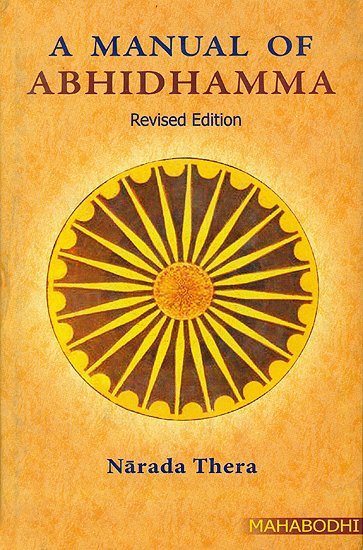A Manual of Abhidhamma
by Nārada Thera | 80,494 words | ISBN-13: 9789380336510
In the Abhidhammattha Sangaha there is a brief exposition of the Law of Dependent Origination, followed by a descriptive account of the Causal Relations that finds no parallel in any other philosophy. Edited in the original Pali Text with English Translation and Explanatory Notes by Narada Maha Thera....
§ 3.
Sabbañ ca pan' etam ahetukam sappaccayam, sāsavam, samkhatam, lokiyam, kāmāvacaram, anārammanam, appahātabbam' evā' ti ekavidham pi ajjhattikabāhi- rādivasena bahudhā bhedam gacchati.
Katham?
- Pasādasankhātam pañcavidham pi ajjhattikarūpam nāma; itaram bāhirarūpam.
- Pasādahadayasankhātam chabbidham pi vatthurūpam nāma; itaram avatthurūpam.
- Pasādaviññattisankhātam sattavidham pi dvārarūpam nāma; itaram advārarūpam.
- Pasādabhāvajīvitasankhātam atthavidham pi indriyarūpam nāma; itaram anindriyarūpam.
- Pasādavisayasankhātam dvādasavidham pi olārikarūpam,
- santike rūpam, sappatigharūpam ca; itaram sukhumarūpam,
- dūre rūpam, appatigharūpam.
- Kammajam upādinnarūpam; itaram anupādinnarūpam.
- Rūpāyatanam sanidassanarūpam; itaram anidassanarūpam.
- Cakkhādidvayam asampattavasena, ghānādittayam sampattavasenā' ti pañcavidham pi gocaraggāhikarūpam; itaram agocaraggāhikarūpam.
- Vanno, gandho, raso, ojā, bhūtacatukkañc' āti atthavidham pi
- avinibbhogarūpam; itaram vinibbhogarūpam.
Icc'evam atthavīsati vidham pi ca vicakkhanā
- Ajjhattikādibhedena vibhajanti yathāraham.
- Ayam' ettha rūpavibhāgo.
(translation)
§ 3.
Now all this matter divides itself into various categories as follows:
- Rootless (35)
- Causal (36)
- With Defilements (37)
- Conditioned (38)
- Mundane (39)
- Pertaining to the Kāma-Sphere (40)
- Objectless (41)
- Not to be eradicated (42)
Matter is thus one-fold. When conceived as personal, external, and so forth, matter becomes manifold.
How?
The five kinds of sensitive material qualities are personal (43); the rest are external.
The six kinds, comprising the sensitives and the heart, are material qualities with basis (44); the rest are without a basis.
The seven kinds, comprising the sensitives and (the two) media of communication, are material qualities with a door (45); the rest are without doors.
The eight kinds, comprising the sensitives, sex-states, and vitality, are material qualities with a controlling faculty (46); the rest are without a controlling faculty.
The twelve kinds, comprising the sensitives and (seven) sense-objects (because "tangibility" comprises the three elements, excluding āpo), are gross (47), proximate, and impinging material qualities; the rest are subtle, distant, and non-impinging.
Material qualities born of Kamma are 'grasped at' (48); the others are 'not grasped at'.
Object of form is visible; the rest are invisible.
Eye and ear, as not reaching (the object), and nose, tongue and body, as reaching (the object), are five kinds of material phenomena that take objects (49); the others do not.
Colour, odour, taste, sap (50), and the four Essentials are the eight kinds (51) of material phenomena that are inseparable; the rest are separable.
Summary
Thus the wise analyze, accordingly, the 28 kinds with respect to 'personal' and so forth.
Herein this is the analysis of Matter.
Notes:
35. Ahetukam - Because they are not associated with the roots lobha, dosa, etc.
36. Sappaccayam - Because they are related to the causes - Kamma. citta, utu, and āhāra.
37. Sāsavam - Since they serve as objects for Defilements.
38. Sankhatam - Because they are conditioned by the four causes - Kamma, citta, etc.
39. Lokiyam - Because they are connected with the world of the Five Aggregates of Attachment (pañcupādānakkhandhaloka). There is no supramundane rūpa.
40. Kāmāvacaram - Because they come within the range of sensual objects.
41. Anārammanam - As they themselves do not perceive objects. It is the mind that perceives objects through the senses. Rūpas serve as sense-objects.
42. Appahātābbam - Because there is no gradual eradication of matter like passions. 'Indestructibility' of matter is not implied by this term.
43. Ajjhattikam - Belonging to the so-called self. The five sensitive organs are essential for living beings. Without them they are inanimate logs. They serve as doors to the mind.
44. i.e., they serve as seats of consciousness.
45. They serve as doors to moral and immoral actions, mind and mental states, deeds and speech.
46. They are so called because they possess a controlling power in their respective spheres. The physical eye, for instance, is composed of ten material qualities; but it is the sensitive eye (cakkhupasādarūpa) that controls the remaining nine. The remaining pasādarūpas should be similarly understood. The state of sex controls masculinity and femininity. Like the captain of a ship it is vitality that controls rūpas.
47. Olārikam - Because of their importance both subjectively and objectively. They are regarded as santike (near) because of their receptivity. Owing to the grossness and nearness both sensitive organs and sense-objects mutually strike each other. Hence they are called sappatigha, lit., 'with striking against'.
See Compendium p. 159, n. 4.
48. Upādinnam - The first 18 kinds of rūpa born of Kamma are grasped by craving and false view.
49. Gocaraggāhikarūpam - They are so called because they take external objects as pasture. According to the Abhidhammattha Sangaha, sight and sound are regarded as objects that do not approach the eye and ear respectively as in the case of bodily contacts, etc. Both eye and ear cognize distant objects without any direct approach. In the case of other objects they directly contact the sense-organs. For instance, taste must directly touch the tongue. So are the other two objects. This may be the reason, irrespective of the wave theory, why the author distinguishes between senses that reach, and do not reach, the objects.
See Compendium, p. 160.
50. Ojā, as a rūpa in itself, has the power of producing other rūpas as well.
51. As a rule these eight rūpas are bound together. The four Essentials are inseparable and so are the four Derivatives. Hence they are also termed 'suddhatthaka' ('pure octad') and 'ojatthaka' ('with ojā as the eighth'). The growth of inanimate matter is also due to the presence of this universal ojā.
